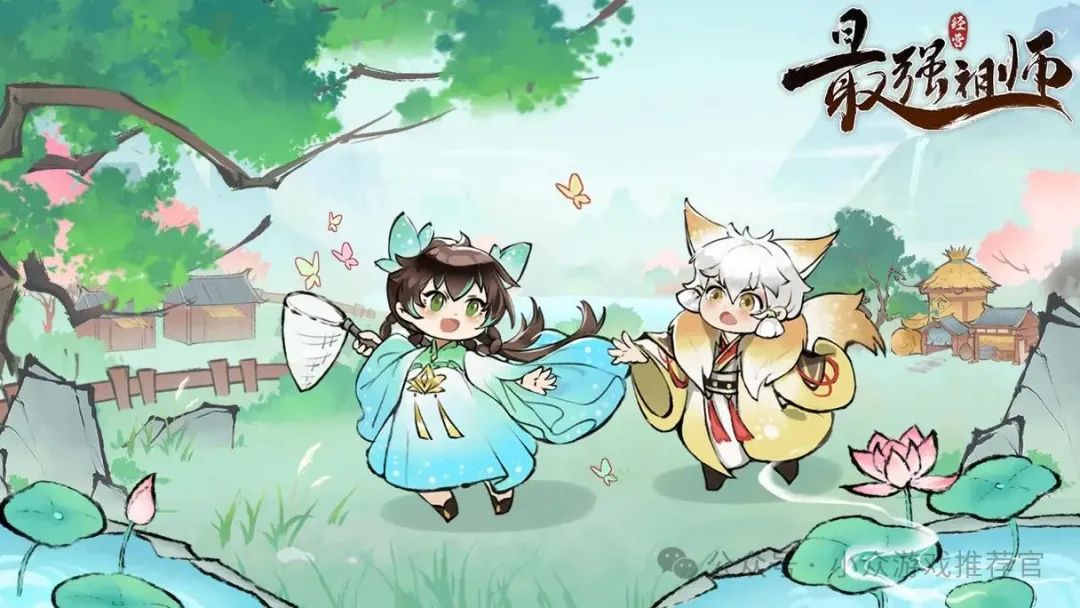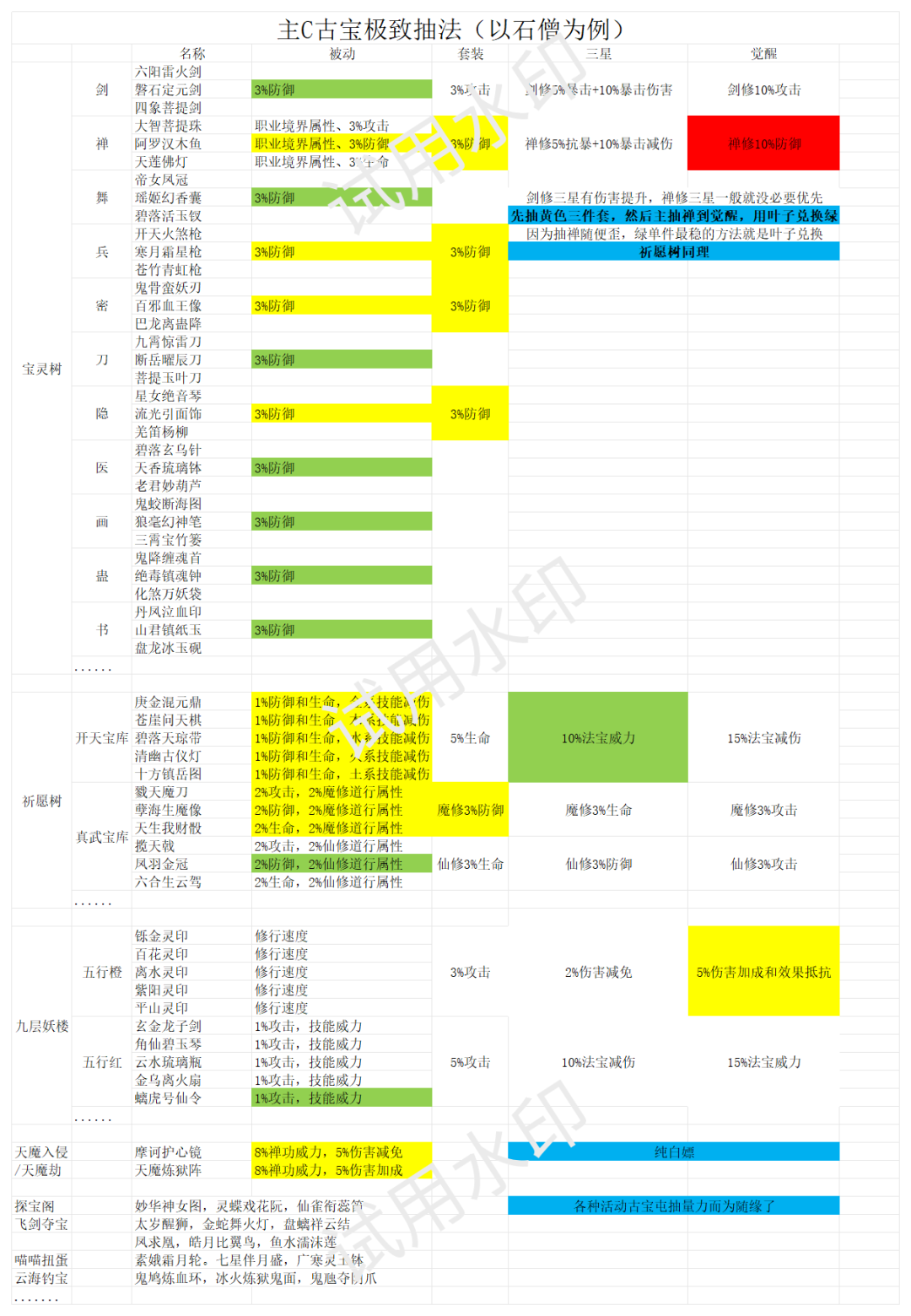
This article explains the cultivation strategy for a main DPS character:
1. Why focus on cultivating a main DPS character to such an extreme?
The goal is to prioritize resource allocation to allow a specific disciple to reach the necessary level of cultivation under limited resources, maximizing the desired benefits. This disciple is referred to as the core damage dealer.
If you opt for an average cultivation approach, it assumes you have the financial means to invest significantly in resources to achieve comparable levels of cultivation across all positions. However, the cost is too high, making it impractical to advance all characters equally. Excelling in one character is already a significant achievement, so if you choose to focus on one, it should be done to the utmost.
2. What aspects are involved in cultivating an extreme main DPS character?
The core damage dealer must be a powerful output disciple, with the basic requirements being full levels of destiny (currently at level 3), realm, body refinement, and body tempering.
If they have a unique weapon, it generally requires financial investment (unless there are alternative options). Prioritize upgrading the weapon’s base to the maximum level; refining is costly but yields minimal returns, so it is not recommended.
Essential financial investment techniques must also be matched (without them, the strength level will drop), along with the corresponding technique study requirements (which can enhance combat power through study attributes).
Find the corresponding top-tier equipment (attributes, sets, enhancements, celestial and demonic items).
Ideal talisman combinations are necessary (main talisman, divine abilities, main talisman refinement, nurturing, enhancement, and breakthroughs).
High-level spirit formations are essential. (At least two level 40 formation maps, and a minimum of level 4 elemental spirit formations with potential attributes)
Mounts can be chosen freely, but clothing should be prioritized for full star upgrades, and professional equipment should be maxed out first.
Appoint a leader, use potions to enhance basic potential values, and ensure six blue talent combat attributes and six red talent combat quirks, along with partner attributes.
Celestial blessings should be reasonable, as should hidden treasures and mutated spiritual roots.
Red ancient treasures should be drawn reasonably. (For example, for an attack-oriented main DPS, prioritize drawing a full set of the same profession—three-piece set bonuses for percentage attack increases, such as sword, knife, book, and curse—mainly draw the profession’s awakened full stars, and exchange leaves for single-piece percentage attack ancient treasures from other professions, or other output ancient treasures that can enhance percentage attack) [If you are not a high spender with full ancient treasures, average draws will fall behind in practical cultivation].
The celestial tree should fully cultivate the main DPS profession, while other professions in the team can focus on speed requirements or cost-effectiveness.
Even small contributions matter.
PS: The advantage of extreme cultivation is significantly higher output, but enhancements from red ancient treasures, professional equipment, and high-level spirit formations are almost irreversible. If you focus on cultivating an attack-oriented character like Han Li, you cannot switch to a defense-oriented character like the Stone Monk; the same applies to others. (Except for high spenders with full ancient treasures, I recommend that most people choose one path and stick to it).
Guide to extreme drawing methods for main DPS ancient treasures (using the Stone Monk as an example)

3. What are the specific benefits of an extreme main DPS?
The output of the extreme main DPS is essentially the primary output of your team. When the output increases, PK, tower climbing, and damage activities all improve. The specific benefits depend on the functional advantages of the chosen core damage dealer.
For example, Han Li: If your main DPS Han Li meets the output standards, in PK, he can wipe out teams, and in tower climbing, he can break through alone, with decent damage output. However, if the output is relatively low, your Han Li in PK will merely scratch the surface, getting stuck in output challenges in tower climbing, and dealing less damage than an ordinary curse team.
4. Overall resource allocation for the team
Thus, an extreme main DPS can only reflect the upper limit of the team’s output, while the overall lower limit is represented by the other four teammates. When you pay attention to the overall resource allocation, disciple combinations, and skill combinations of your team, you are already a PK expert. Average cultivation has a high threshold; focusing solely on the core damage dealer while neglecting other teammates is also unwise. A balanced approach while ensuring a solid foundation is appropriate.
I believe a reasonable resource allocation is: extreme focus on one core damage dealer, one or two secondary resource cultivation positions (which may deserve more attention), and the rest should at least have basic resource cultivation, with any surplus resources later used to nurture the second and third teams.
5. Targeting and defense in PK (example: Stone Monk team vs. Han Li team)
With such extreme cultivation, shouldn’t we consider PK to show off?
Typical Han Li team: Qingzhu Sword Han Li, Ao Tian, Painter, Tang Dieyi, Five Elements Zen. The combination of Painter and Tang with Han Li can likely wipe out teams or eliminate revival positions, leading to a high probability of victory.
Typical Stone Monk team: Ao Tian stands firm, Stone Monk, Dizang revives Zen/Purple Spirit, Xiao Chen/A Li/Functional Zen, Burning Spirit Sacrifice Zen. By using Burning Spirit and the third-tier flower to activate the talisman in the first round, relying on the invincible shield to sustain until the Stone Monk activates, they have a high probability of winning. / Purple Spirit can reflect Painter’s ban, eliminating the need for imitation (Painter’s counter can use Jade Flute or be placed in the front row to absorb the immunity from Ming Jin).
Counter for Han Li team: Spirit Sacrifice Tang Dieyi + Painter’s imitation can likely activate Han Li early, leading to a high probability of wiping out the team.
Counter for Stone Monk team: Double Burning Spirit positions (Burning Spirit Zen + Burning Spirit A Li) may also use the Shattering Spirit Curse.
Counter for Han Li team: Adding Tang Dieyi to strengthen revival weaknesses, boosting Han Li’s attack output to extreme levels (financial investment translates to cultivation differences).
If you are a PK player, you must recognize a reality: the financial threshold for Han Li in PK is very high (just enhancing Han Li requires at least 5k+ investment, not to mention teammates), and it is not enough to just have a weapon and a few techniques to guarantee victory against the same level. Without financial investment in ancient treasures and spirit formations, the attack will not meet the standards, and you will lose to a zero-investment monk team. Only with high financial investment translating into cultivation and explosive output will you be strong.
The financial threshold for the Stone Monk in PK is very low; with Zen, or even just Da Huang, you can achieve strong PK effects even without any investment. The Stone Monk’s teammates are also low-cost. However, this disciple has a low upper limit for financial investment, and when facing tank teams, it can easily lead to a 20-round battle.
6. Do not overlook the cultivation of the second and third teams
This game increasingly requires multiple disciples to participate, and I believe the second and third team strategies mainly serve to support eliminated disciples. Cultivating them means there are no useless disciples, unless you reach a level where the second and third teams overflow, leading to complete elimination of some disciples.
7. Application of strategies in the early game (for beginners)
Positioning: core damage dealer, secondary resource cultivation positions. Accessories, accessories, accessories. The sixth person (required for main quests, back mountain, and sect competitions).
Characters: Five Elements Sword, Panda. Yang An, Tang Dieyi. Bai Ziling, / Han Feiyu, / Lin Qingyao.
Realm (refining void is the basis for opening two skill slots)
Refining void early stage, refining void early stage, refining void early stage, refining void early stage, refining void early stage, transforming spirit early stage
Prioritize perfection, secondary perfection, refining void early stage, refining void early stage, refining void early stage, final breakthrough
Refining void perfection, refining void perfection, prioritize perfection, secondary perfection, refining void early stage, refining void early stage
Combining early stage, combining early stage, combining early stage, combining early stage, refining void early stage, refining void early stage
Prioritize perfection, combining early stage, combining early stage, combining early stage, secondary breakthrough, refining void early stage
Combining perfection, prioritize perfection, secondary perfection, combining early stage, combining early stage, refining void early stage
Great Ascension early stage, Great Ascension early stage, Great Ascension early stage, combining early stage, combining early stage, prioritize combining
Prioritize perfection, secondary perfection, Great Ascension early stage, combining early stage, combining early stage, combining early stage
And so on… In summary, the leveling progress is too fast; any resources should first be tilted towards the top, and later supplement the basics.
Body refinement follows the same principle. However, the transforming spirit realm can shatter voids, and the combining realm can reach the earth level. Generally, you should first cultivate the Five Elements Sword, then feed the Panda, and finally supplement the basics for the other three characters at two lower realms (e.g., Five Elements Sword at earth level and Yang An at void level), with the sixth person being one realm lower than Yang An.
Treasures (first-tier treasures can be used for a week without much concern, second-tier treasures for more than half a month, mainly focusing on third-tier)
Only enhance the main DPS’s fire melting crystal; others can use first-tier wood scales/fire shells/fire spiritual herbs/Yuqing bamboo/fire silk without enhancement.
Only enhance the main DPS’s fire copper/fire bones; others can use second-tier soul nurturing wood/fire scales/golden sun ginseng/wood sand/cold smoke jade, which are quite effective without enhancement.
Third-tier follows the same principle
Equipment
Set combinations: Five Elements Sword three Asura sets, Panda Mingguang set, Yang An King Kong set, and other Mingguang sets. Tang Dieyi can use 3 Mingguang/3 Yunge/2 Yunge 2 Mingguang/2 Asura 2 Blood Hunter (blue 1 starts dancing), switching as needed.
Find attributes: Five Elements Sword attack % critical % critical damage %, others life % defense %, Tang Dieyi can consider speed critical %
Enhancements: Good attribute sets for Five Elements Sword and Panda can be enhanced, while Tang Dieyi’s shoes can be enhanced; other enhancements waste spirit stones just to boost combat power.
What do you think? Leave a comment!
This article is a repost!Original authorShenshan Xizhao Qiuyuhas elaborated on their understanding, and everyone can also share their different views on the game. After all, communication leads to better understanding, and I hope everyone can enjoy the game together! The usual rule: good comments, regardless of viewpoint, will be highlighted!